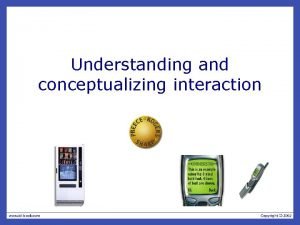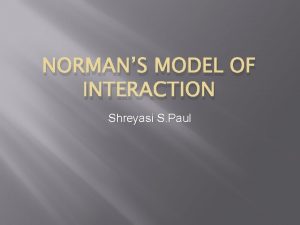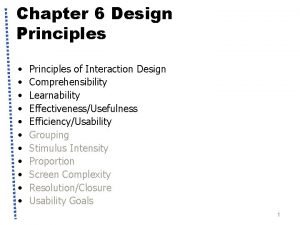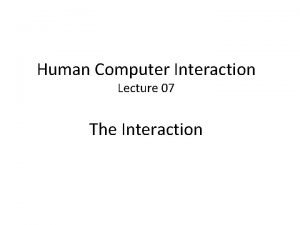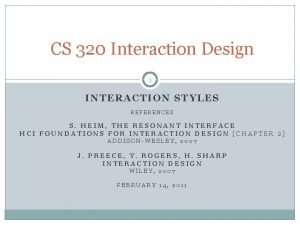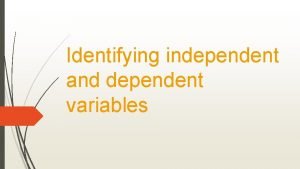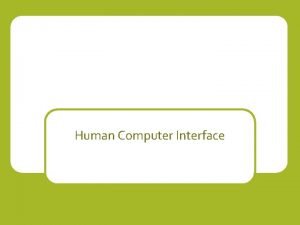HumanComputer Interaction HCI Mario agalj University of Split





































- Slides: 37

Human-Computer Interaction (HCI) Mario Čagalj University of Split

Using Colors Effectively in Graphical Design Based on: „Designing with the Mind in Mind” by Jeff Johnson „Non-Designers Design Book” by Robin Williams

Introduction Color is a powerful (visual) communication meduim shapes our perception, interpretetion and memory or what we see • it can enhance the effectiveness of a message • likewise, it may imapir it • 3

Introduction Human color perception has both strengths and limitations vision is optimized to detect contrast (edges), not absolute brightness • our ability to distinguish colors depends on how colors are presented • color-blindeness • the user’s display and the enviromental conditions affect color perception • 4

How color vision works? Trichromatic and opponent-process theory of color vision Based on: „Designing with the Mind in Mind” by Jeff Johnson

How color vision works? An eye focuses light on the retina at the back of the eye Retina has two types of light photoreceptor cells • • rods – detect light levels (brightness) but not colors cones – detect colors sensitive to red light • sensitive to green light • sensitive to blue light • • other colors detected through different combinations of RGB 6

How color vision works? Most of the time, our vision is based entirely on input from cones Rods are barely used (only in poorly lighted enviroments) • • dinner by candlelight dark house walking a dog after dark those who live in industrialized societies hardly use their rods at all 7

How color vision works? The relative quantities of the three cone types are approximatelly in the ratio red: green: blue = 40: 20: 1 The eye’s overall sensitivity to b is much lower than to r and g 8

How color vision works? Color-sensitive photoreceptors (cones) are sensitive to wider range of light frequencies • • their sensitivity ranges overlap considerably their sensitivity differs considerably Retinal receptors Artifitial RGB receptors 9

How do we see a broad range of colors? Our brain combines the signals from the cones by subtraction • It is more efficient to record differences between the responses of the cones, rather than cone's individual response (they overlap in response) • Neurons in the visual cortex (at the back of our brain) subtruct signals coming over the optic nerves • • from the green (medium- ) and red (low-frequency) cones, producing red-green difference channel • from the high- and low-frequency cones, yielding a yellow-blue difference channel • Finally, a third group of neurons adds the signals coming from the low- and medium-frequency cones to produce an overall luminance (black-white) channel These 3 channels are called color-opponent channels 10

Implications of color processing theories Based on: „Designing with the Mind in Mind” by Jeff Johnson

Vision is optimized for contrast, not brightness Oponnent color process (subtractions) make our visual system much more sensitive to differences in color and brightness (contrast) than to absolute brightness levels 12

Vision is optimized for contrast, not brightness Oponnent color process (subtractions) make our visual system much more sensitive to differences in color and brightness (contrast) than to absolute brightness levels 13

Vision is optimized for contrast, not brightness Oponnent color process (subtractions) make our visual system much more sensitive to differences in color and brightness (contrast) than to absolute brightness levels The squares marked A and B are the same gray! We see B as white because it is shaded by the cylinder. 14

Ability to discriminate colors Even our ability to detect color differences is limited; it depends on how colors are presented Three presentation factors affect our ability to distinguish colors • Paleness: the paler (less saturated) two colors are, the harder is to tell them apart • Color patch size: the smaller or thinner objects are, the harder it is to distinguish their colors • Separation: the more separated color patches are, the more difficult it is to distinguish their colors, especially if the separation is great enough to require eye motion between patches 15

Limited ability to discriminate colors Example: white and pale yellow to indicate the current step in the reservation process Example: tiny color patches hard to distinguish 16

Limited ability to discriminate colors Example: Large color patches make it easier to distinguish the colors 17

Limited ability to discriminate colors Example: Color contrast between visited and unvisited links too subtle. Moreover two shades of blue color used; the color range in which our eyes are least sensitive. 18

Color-blindness Being color-blind does not mean seeing grey or black and white It means that one or more color subtraction channels do not function normally • It becomes difficult to distinguish certain pairs of colors Approximatelly 8% of male and around 0. 5% female population suffer some form of color-blindness • • The most common type of colorblindness is red/green This means that your boss or even worse your investor is potentially affected Alex Bigman @99 designs. com 19

Some guidelines for using colors Based on: „Designing with the Mind in Mind” by Jeff Johnson

Some guidelines for using colors Make sure the contrast between colors is high (but see later) • One way to test whether colors are different enough is to view them in grayscale (if not distinguishable in grays, they aren’t different enough) Use distinctive colors • • Our visual system combines the signals from retinal cone cells to produce color opponent channels: red-green, yellow-blue, and black-white The collors that people distinguish most easily are those that cause a strong signal on one of the three channles, and neutral signals on the other two channels 21

Some guidelines for using colors Avoid color pairs that color-blind people cannot distinguish normal color vision (1% of male population) (6% of male population) (1% of male population) Use color redundantly with other signifiers • E. g. Use different color + different symbol Separate strong opponent colors • Placing them right next to each other causes a flickering sensation 22

Some good examples Example: white, yellow and blue to indicate the current step in the reservation process 23

Some good examples Example: white, yellow and blue to indicate the current step in the reservation process 24

The amazing color wheel Based on: „Non-Designers Design Book” by Robin Williams

The color wheel Amazingly useful when you need to make a conscious decision about choosing colors for a project The color wheel begins with yellow, red, and blue (primary colors) • cannot result from mixing of other colors 26

The color wheel If you take your watercolor box and mix each of these colors with an equal amount of the one next to it, you’ll get the secondary colors 27

The color wheel To fill in the empty spots in the color wheel, mix equal parts of the colors on each side to obtain tertiary colors 28

Color relationships So now we have a color wheel with the basic twelve colors With this color wheel, we can create combinations of colors that are pretty much guaranteed to work together 29

Color relationships: complementary Colors directly across from each other, exact opposites, are complements • Because they’re so opposite, they often work best when one is the main color and the other is an accent 30

Color relationships: triads A set of three colors equidistant from each other always creates a triad of pleasing colors • Red, yellow, and blue is an extremely popular combination for children’s products - primary triad 31

Color relationships: triads Another form of a triad is the split complement • • • Choose a color from one side of the wheel Find its complement directly across the wheel Use the colors on each side of the complement 32

Color relationships: analogous colors An analogous combination is composed of those colors that are next to each other on the wheel • No matter which two or three you combine, they all share an undertone of the same color, creating a harmonious combination 33

Extending the wheel: shades and tints Hue = the pure color Shade = color + black (reduces lightness) Tint = color + white (increases lightness) 34

Shades and tints: monochromatic colors Combination composed of one hue with any number of its corresponding tints and shades 35

Shades and tints in combination Choose one of the four color relationships described on Color Relationships slides, but instead of using pure colors (hues), use various tints and shades of those colors This expands your options tremendously, but you can still feel safe that the colors work together 36

For more suggestions and ideas 37
 Agalj
Agalj Agalj
Agalj Ac mario
Ac mario Splitless injector
Splitless injector Hci interaction styles
Hci interaction styles Norman's seven stages of action
Norman's seven stages of action Modelling rich interaction
Modelling rich interaction Paradigms of interaction in hci
Paradigms of interaction in hci History of hci
History of hci Interaction framework in hci
Interaction framework in hci Hci in the software process
Hci in the software process Emotional interaction in hci
Emotional interaction in hci Flight level
Flight level What is wimp in hci
What is wimp in hci Interaction styles in hci
Interaction styles in hci Umd hci
Umd hci Herszon kherson maritime college of merchant marine fleet
Herszon kherson maritime college of merchant marine fleet Dependent vs independent variable
Dependent vs independent variable 詹景裕
詹景裕 Trunk test in hci
Trunk test in hci Cci in ubiquitous computing
Cci in ubiquitous computing Cmu hci minor
Cmu hci minor Stanford hci
Stanford hci Cs 147
Cs 147 Robustness in hci
Robustness in hci Principles of hci
Principles of hci Hci consists of three parts:
Hci consists of three parts: Hci life cycle model
Hci life cycle model What is pact analysis
What is pact analysis What is hci
What is hci Introduction of hci
Introduction of hci Information reproduced from memory can be assisted by cues
Information reproduced from memory can be assisted by cues Icon design in hci
Icon design in hci In hci
In hci Defination of hci
Defination of hci Benefits of command line interface
Benefits of command line interface Understanding business functions in hci
Understanding business functions in hci Hci user interface
Hci user interface




